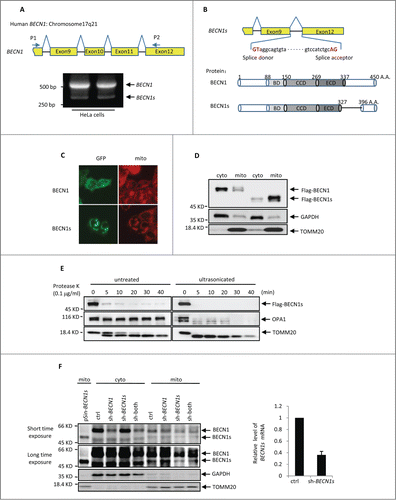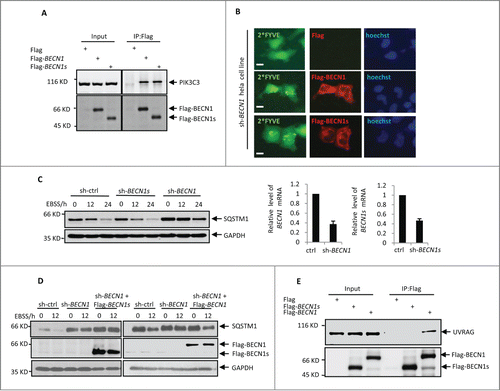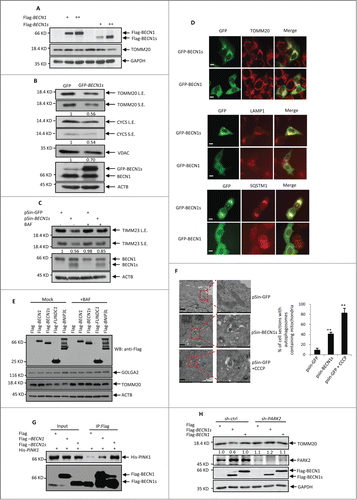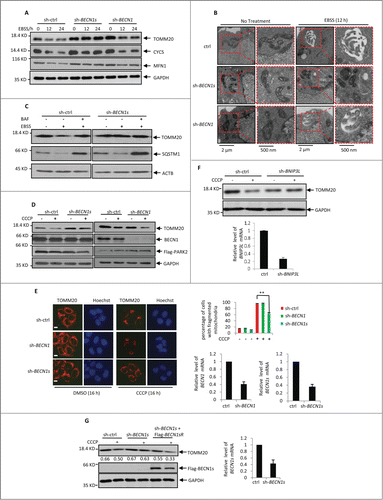Figures & data
Figure 1. BECN1s is a splice variant of BECN1 (A) RT-PCR was performed with total RNAs extracted from HeLa cells using primer P1 and P2. The locations of P1 and P2 on BECN1 cDNA are indicated. (B) A schematic illustration of cDNA and protein sequences of the BECN1 and BECN1s. BD, BCL2 binding domain; CCD, coiled-coil domain; ECD, evolutionarily conserved domain. (C) HeLa cells expressing either GFP-BECN1 or GFP-BECN1s were stained with MitoTracker Red. The images were taken under a fluorescence microscope. (D) HEK 293T cells were transfected with either Flag-BECN1 or Flag-BECN1s. Twenty-four h after transfection, cells were subjected to cytoplasm/mitochondria subcellular fractionation. Proteins from cytoplasmic and mitochondrial fractions were analyzed by western blot. GAPDH and TOMM20 were used as markers for cytoplasmic and mitochondrial fractions, respectively. (E) HEK 293T cells were transfected with Flag-BECN1s. Twenty-four h after transfection, cells were homogenized for mitochondria isolation. The isolated mitochondria were then treated with proteinase K for the indicated periods of time before or after supersonic treatment, followed by western blot analysis to detect Flag-BECN1s levels. (F) HeLa cells expressing the indicated shRNAs and BECN1s proteins were subjected to cytosolic and mitochondrial subcellular fractionation. Sh-both indicates the shRNA targeting both BECN1 and BECN1s. Proteins from cytoplasmic and mitochondrial fractions were analyzed by western blot using anti-BECN1 antibody. GAPDH and TOMM20 were used as markers for cytoplasmic and mitochondrial fractions, respectively. The BECN1s knockdown efficiency was also shown.

Figure 2. BECN1s is not involved in macroautophagy initiation. (A) HEK 293T cells were transfected with control vector, Flag-BECN1, or Flag-BECN1s as indicated. Twenty-four h later, cell lysates were immunoprecipitated with anti-Flag antibody, followed by western blot analysis with anti-PIK3C3 antibody. (B) HeLa cells with BECN1 stable knockdown were transfected with GFP-2*FYVE plus either control vector, Flag-BECN1, or Flag-BECN1s as indicated. Twenty-four h after transfection, cells were immunostained with anti-Flag antibody. The images were taken under a fluorescence microscope. Scale bar: 20 μm. (C) HeLa cells expressing control shRNA, BECN1 shRNA, or BECN1s shRNA were treated with EBSS for the indicated periods of time. Cell lysates were then analyzed by western blot with anti-SQSTM1 and anti-GAPDH antibodies. The shRNA-mediated knockdown efficiency for BECN1 and BECN1s was also shown. (D) HeLa cells expressing the indicated shRNAs and proteins were treated with EBSS for the indicated periods of time. Cell lysates were then analyzed by western blot with anti-SQSTM1, anti-Flag and anti-GAPDH antibodies. (E) HEK 293T cells were transfected with either control vector, Flag-BECN1 or Flag-BECN1s as indicated. Twenty-four h after transfection, cell lysates were immunoprecipitated with anti-Flag antibody, followed by western blot analysis with anti-UVRAG and anti-Flag antibodies.

Figure 3 (See previous page). BECN1s induces mitophagy. (A) HeLa cells were transfected with the increasing amounts of constructs encoding either Flag-BECN1 or Flag-BECN1s. Twenty-four h after transfection, cell lysates were analyzed by western blot with anti-Flag, anti-TOMM20 and anti-GAPDH antibodies. (B) HeLa cells were transfected with either GFP control vector or GFP-BECN1. Twenty-four h after transfection, cell lysates were analyzed by western blot with the indicated antibodies. The blots were also qualified by using Gel-Pro analyzer software (Rockville, MD, USA). The value of each band indicates the relative expression levels of the indicated protein after normalizing to the loading control ACTIN. L.E. and SE indicate long time exposure and short time exposure, respectively. (C) HeLa cells were infected with lentiviruses expressing GFP or BECN1s. Forty-eight h after infection, cells were treated with or without BAF for another 12 h. Cell lysates were then analyzed by western blot with anti-TIMM23, anti-BECN1 and anti-ACTIN antibodies. The blot was also qualified by using Gel-Pro analyzer software (Rockville, MD, USA). The value of each band indicates the relative expression levels of TIMM23 after normalizing to the loading control ACTIN. L.E. and SE indicate long time exposure and short time exposure, respectively. (D) HeLa cells were transfected with either GFP control vector or GFP-BECN1s. Twenty-four h after transfection, cells were immunostained with anti-TOMM20, anti-LAMP1 and anti-SQSTM1 antibodies, respectively. Scale bar: 20 μm. (E) HeLa cells were transfected with the constructs encoding Flag-BECN1, Flag-BECN1s, Flag-BNIP3L and Flag-FUNDC1 as indicated. Twenty-four h after transfection, cells were treated with or without BAF for another 12 h. Cell lysates were analyzed by western blot with the indicated antibodies. (F) Cells expressing GFP or BECN1s were treated with or without Carbonyl cyanide m-chlorophenylhydrazone (CCCP) for 12 h. Cells were then subjected to electron microscopy analysis. The shown images are representatives of 3 independent experiments. Scale bar: 1 μm. The percentage of cells with autophagosomes containing mitochondria is also shown as mean±SD from 3 independent experiments. n>28 cells per experiments. **, P<0.01. (G) HEK 293T Cells were transfected with Flag-BECN1, Flag-BECN1s and His-PINK1 in the indicated combinations. Twenty-four h after transfection, cell lysates were immunoprecipitated with anti-Flag antibody, followed by western blot analysis with anti-His antibody. (H) SH-SY5Y cells expressing control shRNA or PARK2 shRNA were transfected with Flag-BECN1 or Flag-BECN1s. Forty-eight h after transfection, cell lysates were analyzed by western blot with anti-TOMM20 antibody. The blot was also qualified by using Gel-Pro analyzer software (Rockville, MD, USA). The value of each band indicates the relative expression levels of TOMM20 after normalizing to the loading control GAPDH.

Figure 4 (See previous page). EBSS- and CCCP-induced mitophagy is BECN1s-dependent. (A) HeLa cells expressing control shRNA, BECN1 shRNA or BECN1s shRNA were treated with EBSS for the indicated periods of time. Cell lysates were analyzed by western blot with the indicated antibodies. The shRNA-mediated knockdown efficiency for BECN1 and BECN1s was shown in Fig. S4A. (B) HCT116 cells expressing the indicated shRNAs were incubated under normal or starvation conditions for 12 h, followed by electron microscopy analysis. (C) HCT116 cells transfected with indicated shRNA were cultured in normal growth medium or treated with EBSS in the absence or presence of BAF. Cell lysates were analyzed by western blot with indicated antibodies. The shRNA-mediated knockdown efficiency for BECN1s was shown in Fig. S4C. (D) HCT116 cells were transfected with Flag-PARK2 plus the indicated shRNAs. Twenty-four h after transfection, cells were treated with 10 μM CCCP for another 16 h. Cell lysates were analyzed by western blot with anti-TOMM20, anti-BECN1 and anti-GAPDH antibodies. The shRNA-mediated knockdown efficiency for BECN1 and BECN1s was shown in Fig. S4E. (E) HeLa cells expressing the indicated shRNAs were treated with 10 μM CCCP for 16 h. Cells were then immunostained with anti-TOMM20 antibody. Scale bar: 20 μm. The percentage of cells with fragmented mitochondria was calculated and shown accordingly. **, P<0.01. The shRNA-mediated knockdown efficiency for BECN1 and BECN1s was also shown. (F) HCT116 cells expressing either control shRNA or BNIP3L shRNA were treated with or without 10 μM CCCP for 16 h. Cell lysates were then analyzed by western blot with anti-TOMM20 antibody. The efficient knockdown of BNIP3L was also confirmed by real-time RT-PCR analysis. (G) Lysates from HCT116 cells expressing the indicated shRNAs and proteins were treated with 10 μM CCCP for 16 h. Cell lysates were analyzed by western blot with antibodies against TOMM20, Flag and GAPDH. The blot was quantified using Gel-Pro analyzer software (Rockville, MD, USA). The value of each band indicates the relative expression levels of TOMM20 after normalizing to the loading control GAPDH. The shRNA-mediated knockdown efficiency for BECN1s was also shown.

